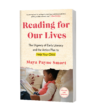By Michelle Luke
Easter. It’s a time of eggs and sweets, beautiful bonnets and celebrations with loved ones, and … So. Many. Plastic Easter eggs! If you’d rather keep them out of the landfill but have way too many for future egg hunts, turn some of them into literacy-supporting maracas that kids can shake along to nursery rhymes and favorite songs.
In this super-easy, two-step craft, you’ll upcycle old plastic eggs into colorful musical instruments to welcome in the spring with a vibrant lyrical celebration. Check out the instructions below, and then read on for tips on how to use your child’s new shaker for maximum brain-building benefit.
Incorporating stories and words with physical activity enhances a child’s story time by tapping into their motor skills and building greater engagement. Speaking in exaggerated, sing-song tones, responding to a child’s verbalizations, and taking turns in conversation are key behaviors that help babies acquire language and older children develop literacy. With these homemade Easter-egg shakers, you’ll incorporate both!
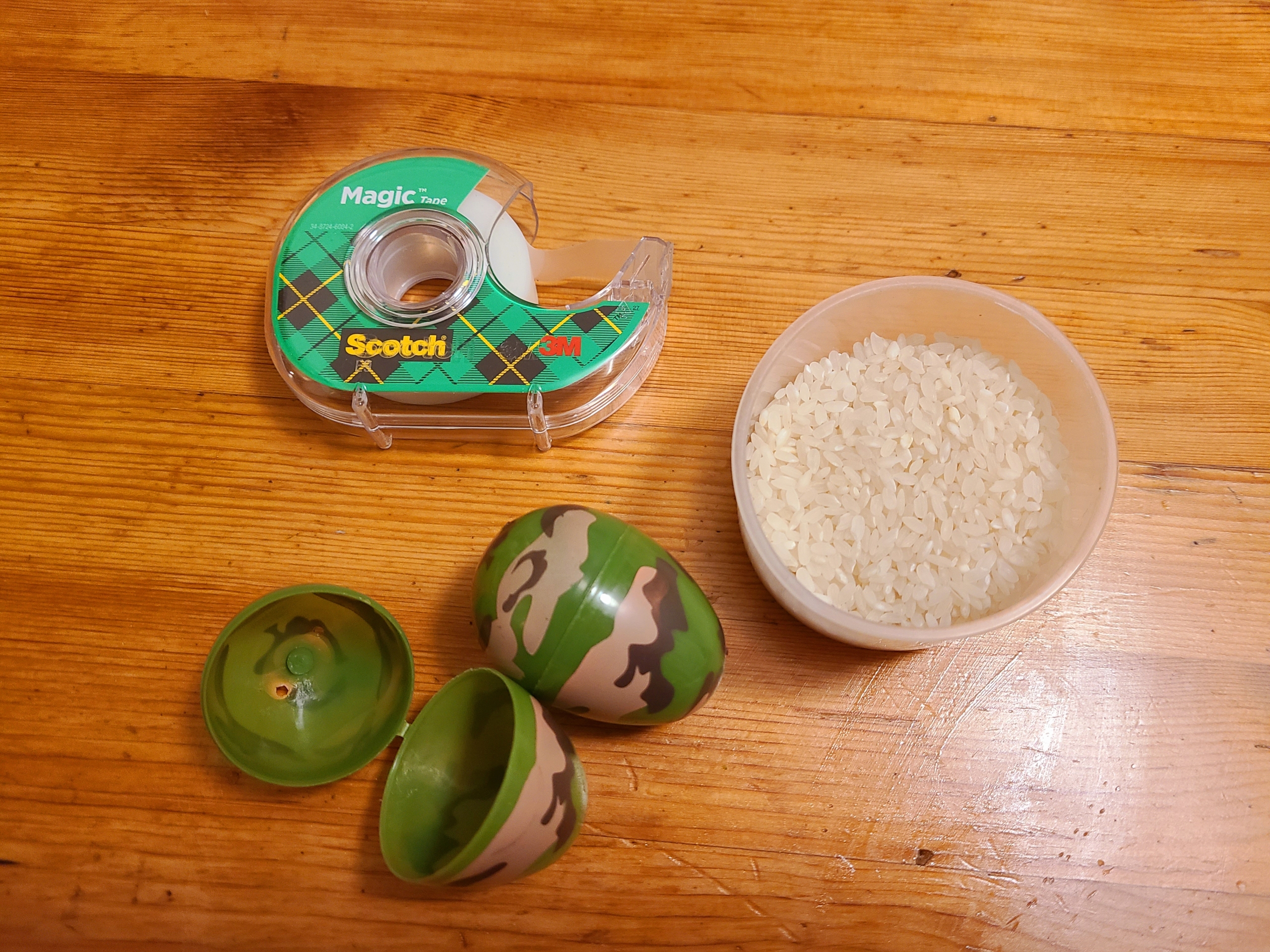
Materials:
- Plastic Easter eggs (as many as you want)
- Dry goods (rice, beans, pebbles, etc.)
- Clear tape
- Mod Podge (optional)
- Colored tissue paper (optional)
Cost: Free! (If you’re one of the rare few who doesn’t have any old plastic Easter eggs on hand, ask around! A neighbor or friend is sure to have one or a million lying around.)
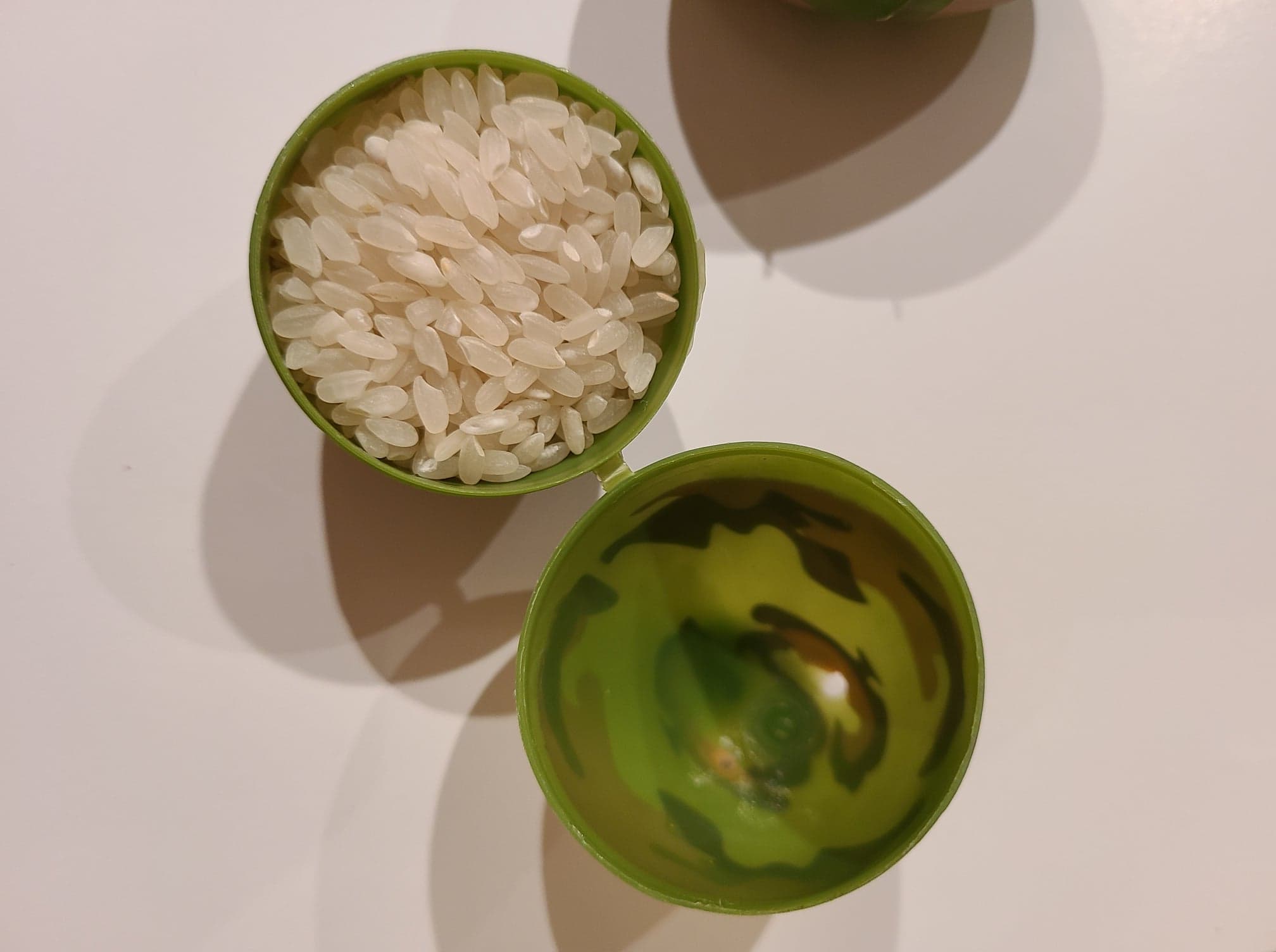
Step 1: Fill your plastic egg(s) with any dry goods of your choice. Rice, beans, or pebbles all work well.
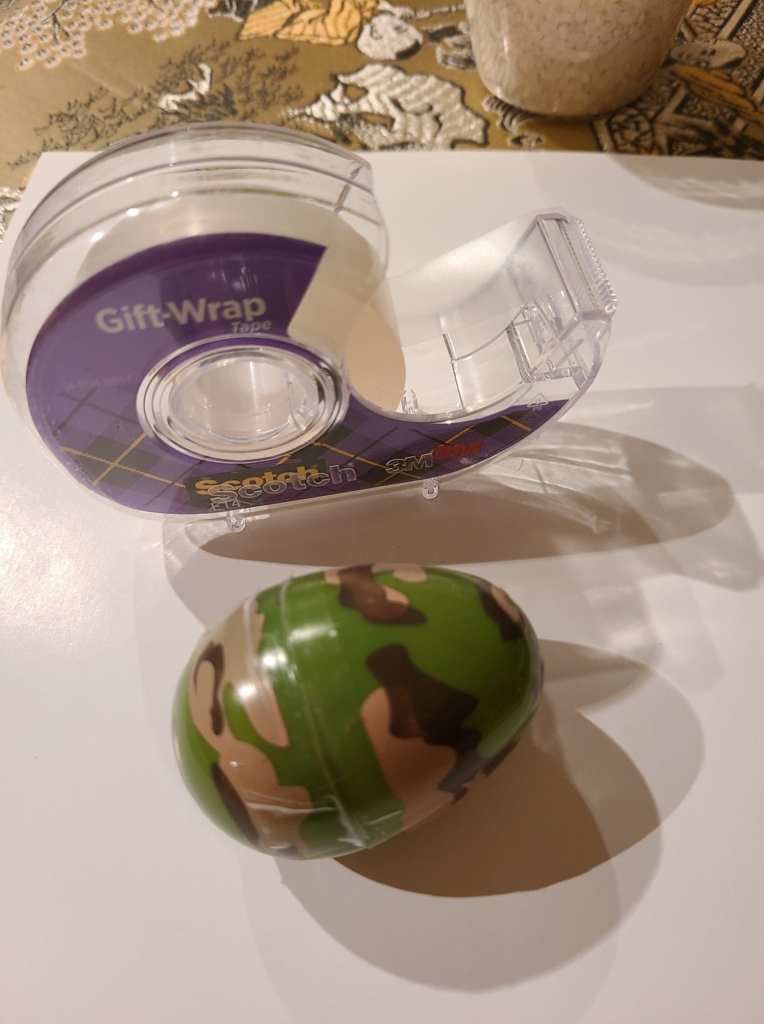
Step 2: Snap the egg shut and tape it closed with a single piece of clear tape. Make sure it’s well sealed.
Bonus step (optional!): The beauty of this craft is that it’s fun, free, insanely easy, and educational! But if you’re ready for a tad more crafting and have some Mod Podge and colored tissue paper on hand, you can also decorate your egg with a tissue-paper collage. Just tear strips of tissue paper and use the Mod Podge to stick it onto your egg after taping it shut.
Congratulations! Your egg is now an instrument that your child can shake along to a favorite nursery rhyme, poem, or song. Invite your child to recite or sing along with you, or let them take the lead. You can participate by clapping along.
Having your child use a shaker to feel the regular cadence of a rhyme’s rise and fall provides a rhythmic template for the developing brain. The emphasis of syllabic meter helps them feel the syncopation of the poem or song, as they engage with it both physically and mentally. See 4 Brilliant Ways Nursery Rhymes Prepare Kids to Read and Write to learn more.
Here are tips for using your shaker to develop important early literacy skills:
- Use your shaker to mark the syllables of your child’s favorite nursery rhyme, having them clap or shake along as you read, emphasizing syllabic meter.
- Use it to keep the beat to your child’s favorite songs, developing in them a sense of syncopation, rhythm, and beat.
- Once your child feels the rhythm of syllables and how they work together in a rhyme, work with them to develop some rhymes of their own that they can recite or sing to the accompaniment of their egg-shaker.
- Enhance the fun (and learning!) by inviting your child to perform his or her own rhyming masterpiece for family members. Hand shakers out to the “audience” to keep the beat as your child recites or sings.
- Your child can even come up with a call-and-response story, where the audience is engaged to use their shakers to emphasize a suspenseful part of the story.
Once you make the shaker, it’s yours to use in so many wonderful ways.
Liked this tutorial? Share it!
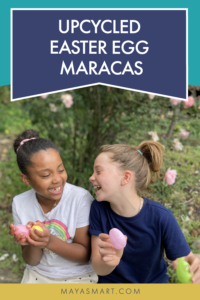
I love a good alphabet book to help kids get practice identifying, naming, tracing, and saying sounds for letters. But they are surprisingly hard to find.
Many alphabet books are designed with older readers in mind, putting more emphasis on specialized vocabulary and background knowledge than basic letter forms and the most common sounds they represent.
Some ABC books feature show-stopping illustrations that distract prereaders from paying attention to the letters at all. Others have fonts that are so faint or frilly that it’s hard to see the specific features that set one letter apart from another—the letters’ lines, curves, and humps.
Still others give too much attention to silent letters, unusual pronunciations, and other content that prereaders aren’t ready for. These may be great tools to work on spelling and reading skills with budding readers, but they’re not what you need to teach your child the alphabet.
The best alphabet books for teaching preschoolers their ABCs (and any kids who are still learning the fundamentals of reading) feature clear, bold uppercase letter forms, minimal text, streamlined illustrations, and words that begin with the most common sounds for the target letters.
There’s no perfect alphabet book—for example, very few feature the most frequently used letter sounds for every letter, as is ideal for beginning learners. But below is our list of some favorite ABC books to get you started. What’s more, each of these titles, besides giving the letters their due, also has a compelling hook that will make your little one want to read them again and again.
ABC Books that Highlight A Letter or Two
ABC Books for Teaching the Full Alphabet
An ABC Book for Teaching Lowercase Letters
If you found this post helpful, please share it!
Easter is coming, and that means egg hunts and baskets full of goodies. Chocolate and jelly beans are fabulous, of course, but if you’re like us you may be seeking additional ways to celebrate that involve a little less sugar. (And dying eggs can only get you so far.)
Don’t worry! We’ve got you covered, with various enriching activities and DIY gifts that offer plenty of Easter fun and build literacy skills at the same time.
We love DIY storytelling dice to get the ball rolling on inventing stories together with your child. This helps kids enrich their oral language, deepen their comprehension, expand their vocabularies, and develop key skills underpinning reading fluency. What’s more, it’s easy and cheap to recycle a couple of old building blocks into your own Easter-themed storytelling dice.
Make them with your child as an activity during the build-up to Easter, or craft them on your own as a cute Easter-basket stuffer. After all, the more space taken up with little novelties, the less room for sweets. And what better way to fill out your little one’s basket than free, educational, and eco-friendly surprises?
Follow the tutorial below, or try our other fun Easter activities.
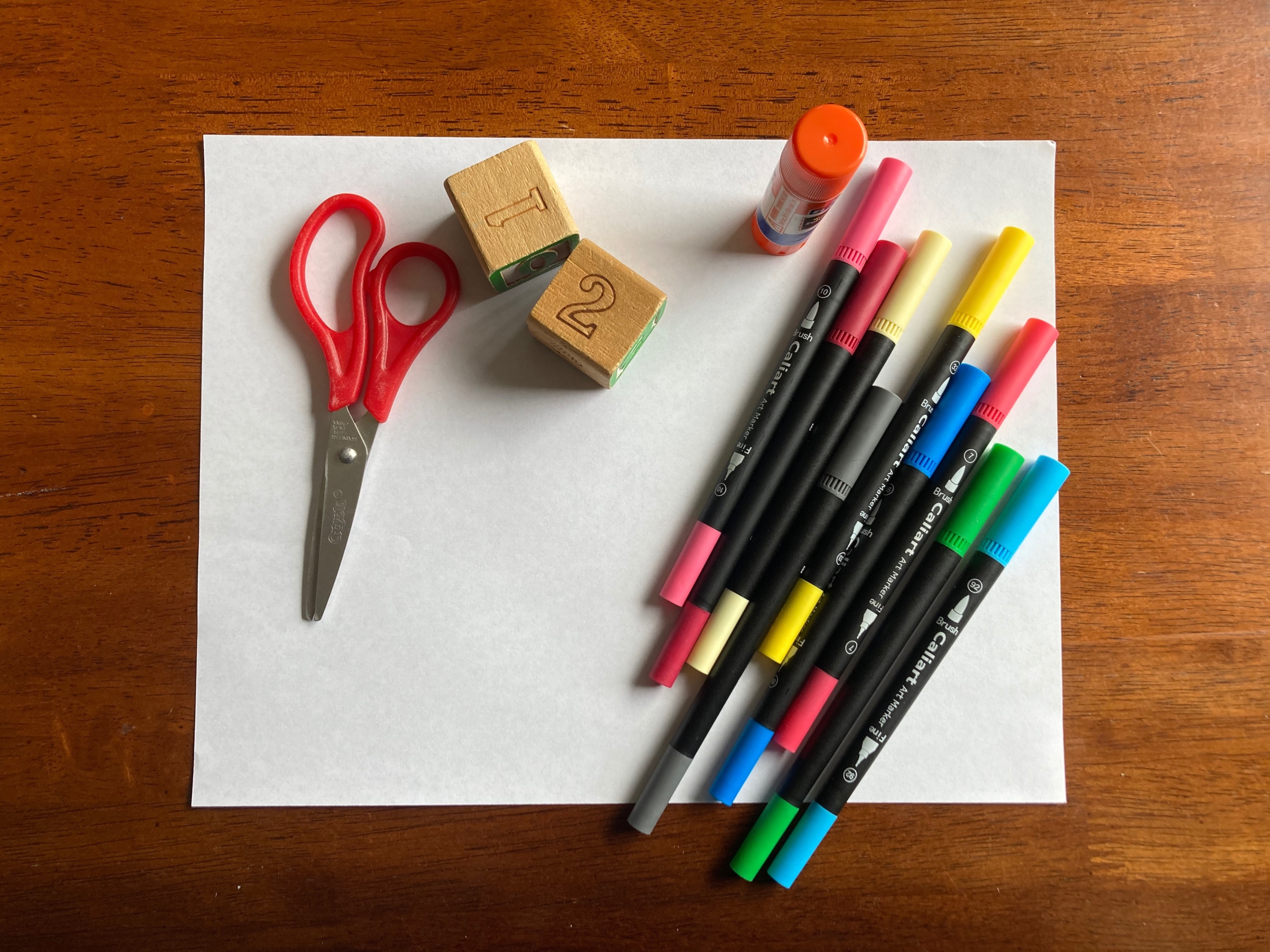
Materials:
- Square building blocks (2)
- Glue or tape
- Paper
- Markers
- Scissors
- Mod Podge (optional)
Cost: Free!
Step 1: Lay your block on a piece of paper and trace it. Repeat 12 times, to make 12 squares. Cut each square out, a little inside the line.
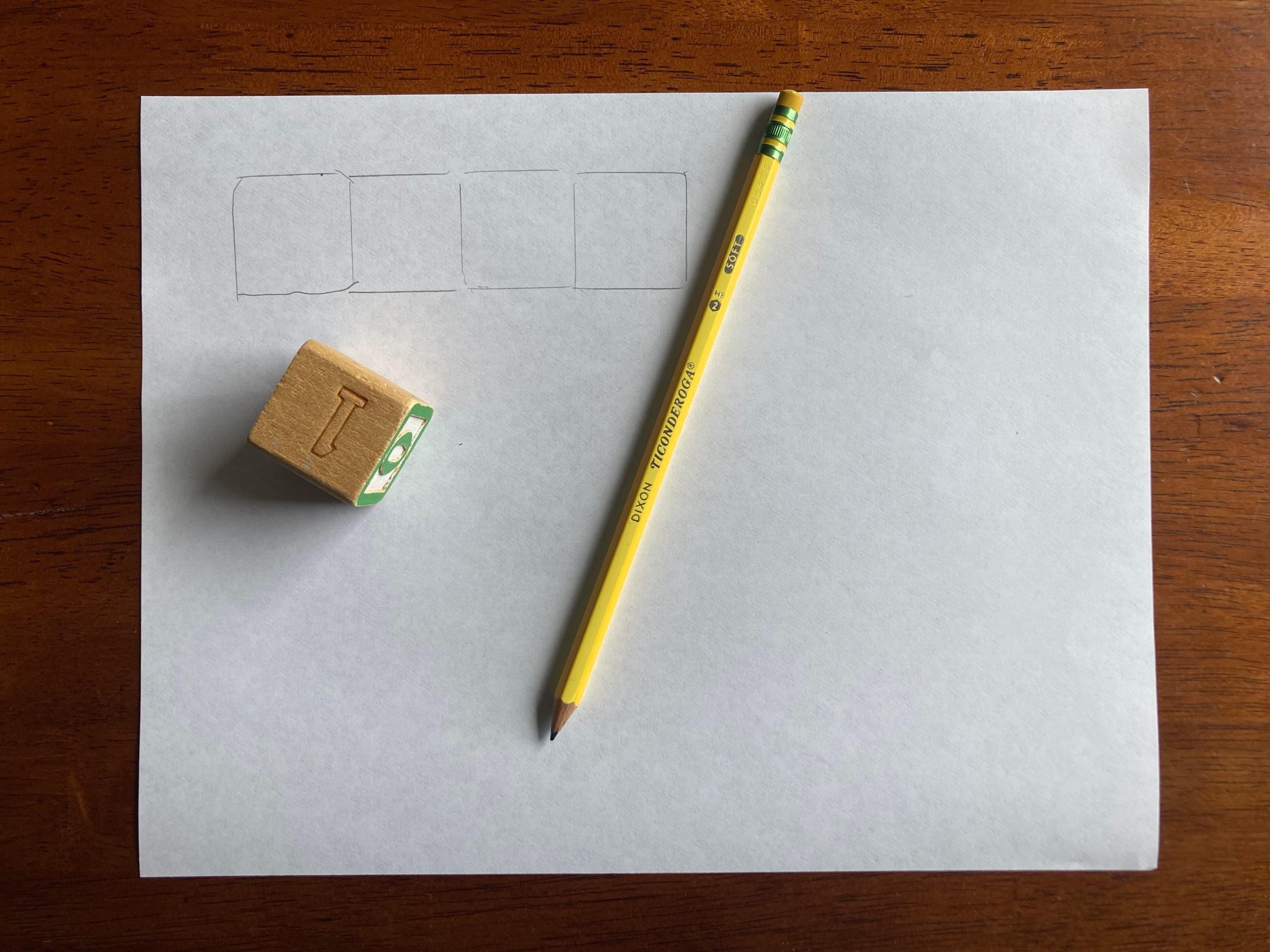
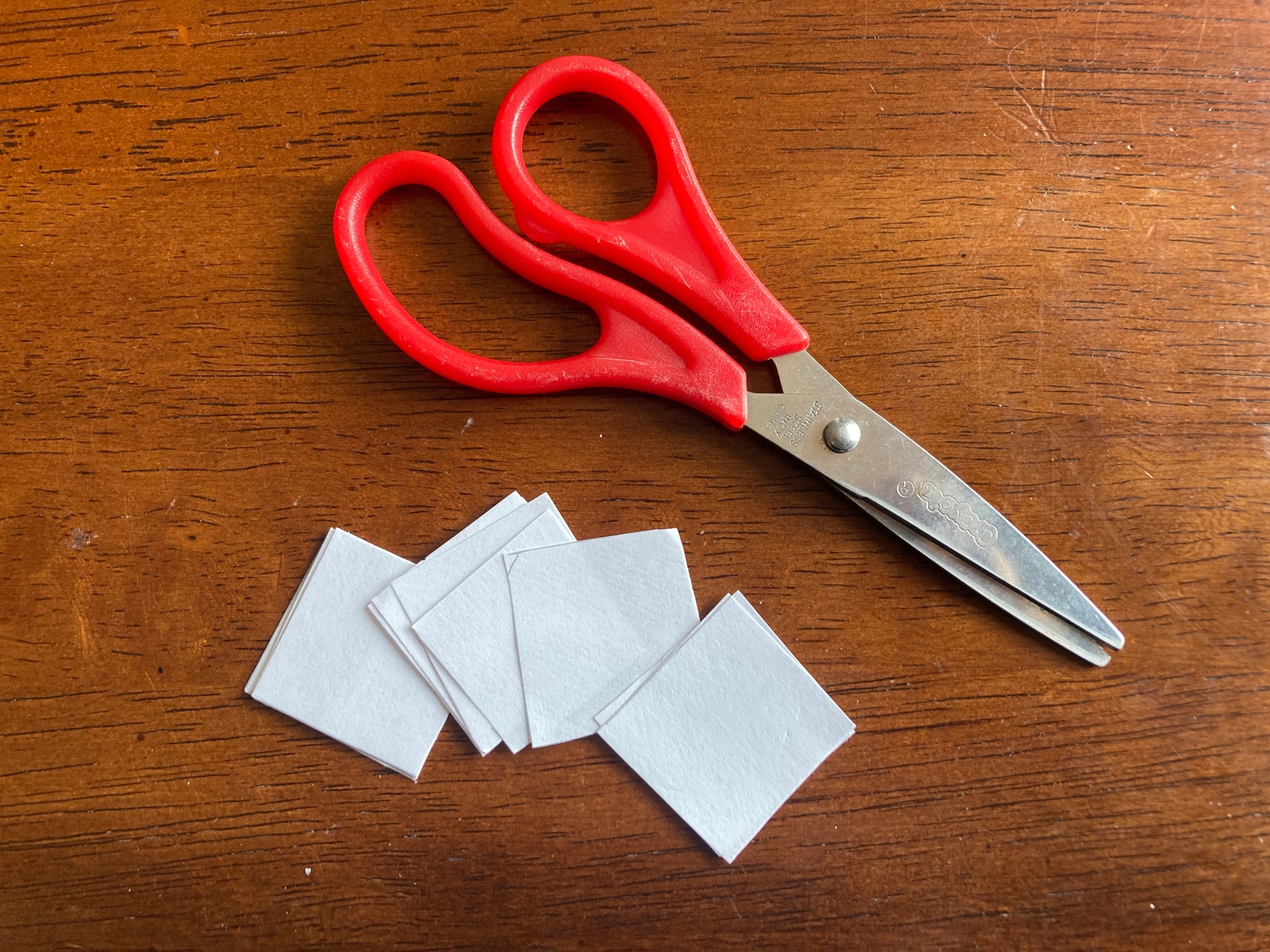
Step 2: Draw simple pictures of Easter and spring-related pictures on six of the paper squares. Then write the name of each item underneath it in clear printing. Then draw another set of the same pictures and labels on the remaining squares, so that you have two of each picture.
Ideas: Bunny, egg, basket, hat, sun, chick, flower, tree, etc.
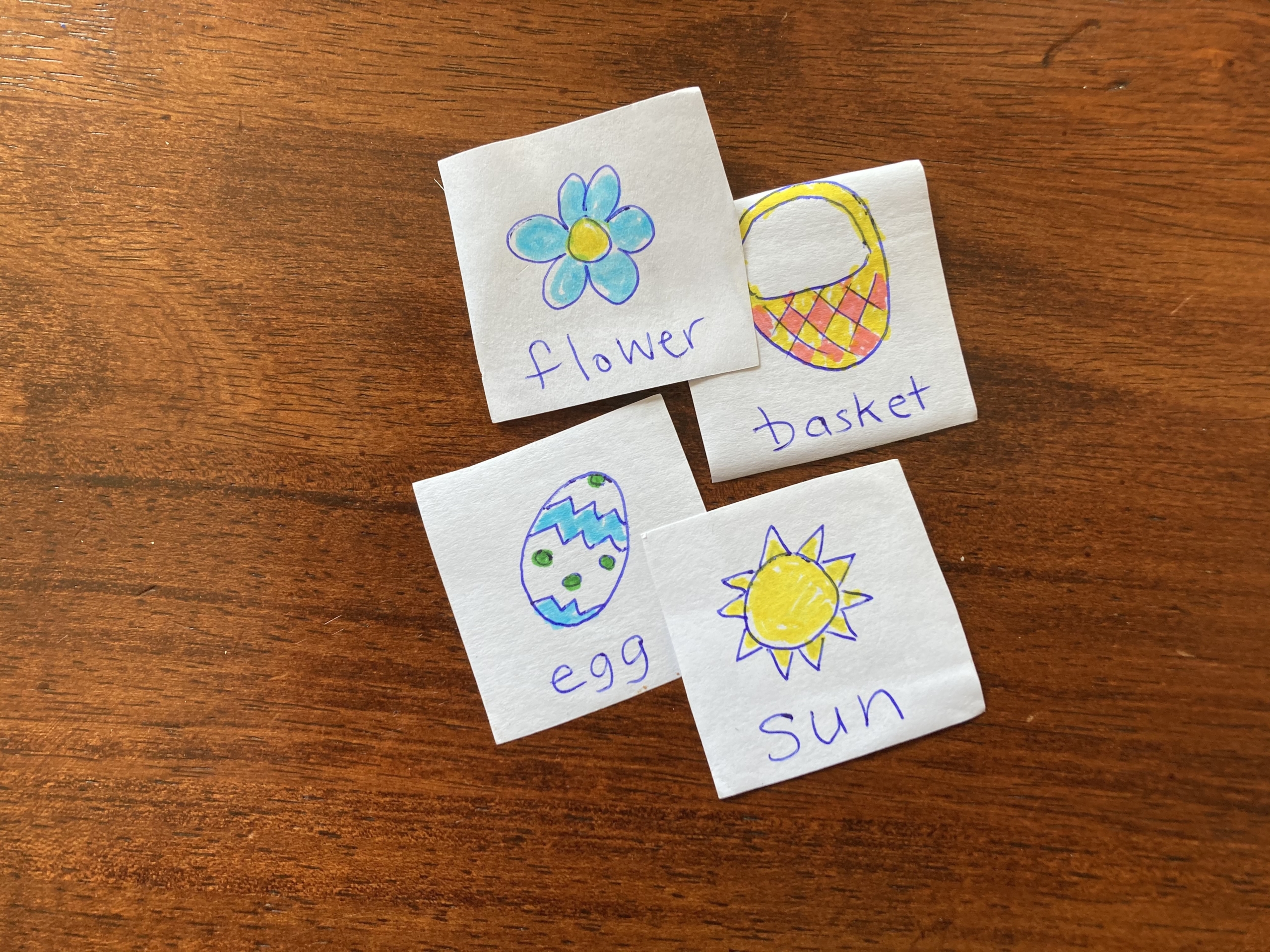
Step 3: Glue or tape the squares on all six sides of your block. Opt for tape if you want to peel off the labels later and return the block to toy duty, or choose glue if you want a more lasting Easter cube. Repeat with additional blocks if you want multiple storytelling dice.
Tip: If you really want to make it last, paint Mod Podge over the papers to give them a protective finish. Do this if you’re making these Easter storytelling dice as an Easter basket gift!
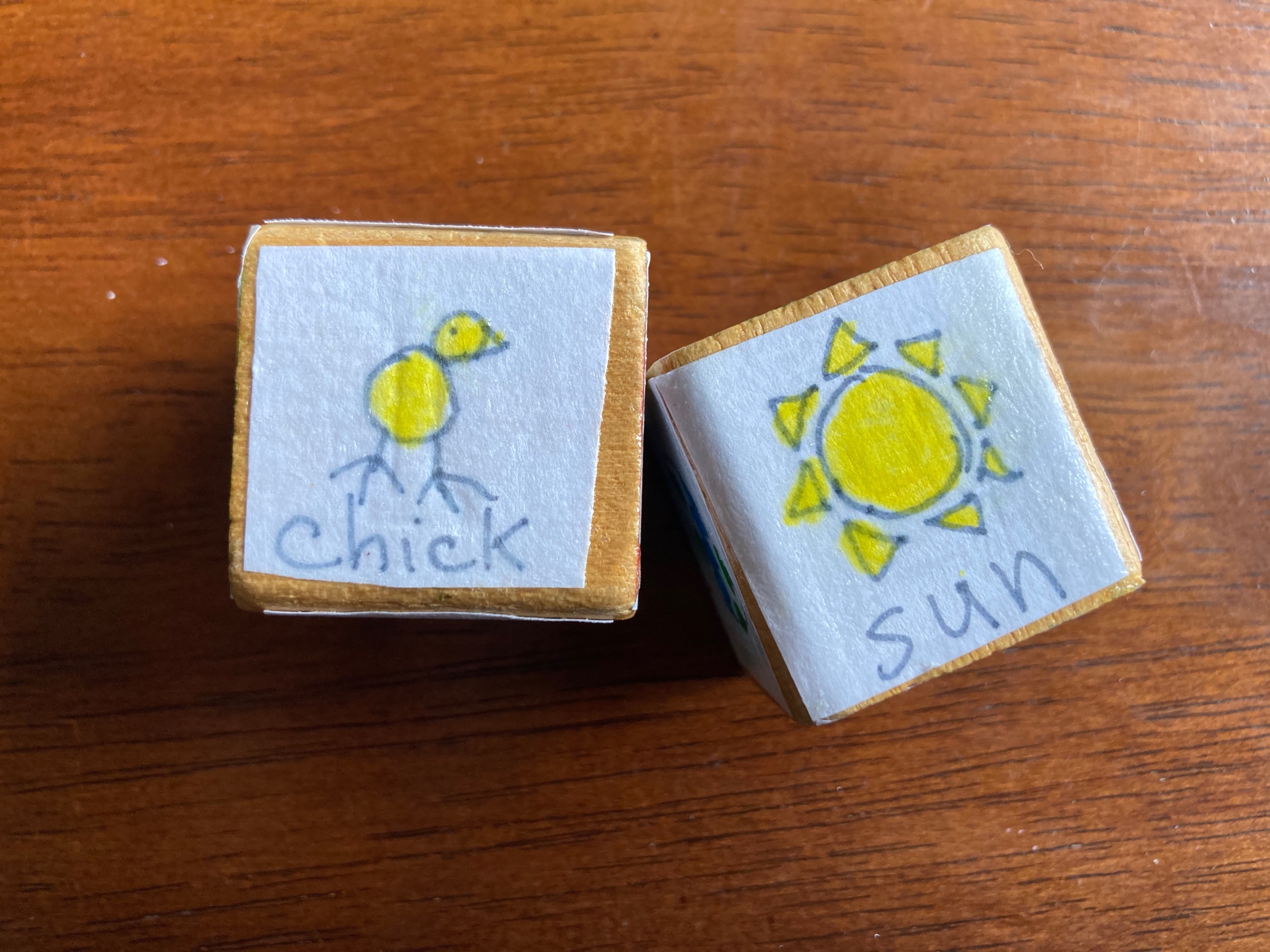
Now your storytelling dice are ready! Time to play. Here’s how: Take turns with your child gently rolling the dice. On your turn, make up a story featuring the two pictures that show up when you roll. (If the same picture comes up on both dice, roll again.)
Go first, to model for your child how to create a story from the prompts. Get creative and use lots of descriptive words to really bring your story to life!
Here’s an example to get your storytelling juices flowing:
Once upon a time, on a sunny Easter morning, a bunny was hopping along in a meadow. Suddenly, she spotted the most beautiful flower she’d ever seen in all her life.
As she stopped and looked around, she realized she’d entered a patch of radiant blossoms in every color of the rainbow. Luckily, she had her Easter basket with her, so she began gathering flowers to take back to her mother, when suddenly …
On your child’s turn, encourage them by listening attentively to their story, showing surprise and excitement as appropriate, laughing out loud if something funny happens, and generally demonstrating that you’re engaged in their story.
As you play, you can gently point out the labels below the pictures. This will help even the youngest kids to develop print awareness and learn that words represent objects. And older kids can begin connecting up the sounds and letter combinations with the items on the dice.
If you’re ready for more complicated stories—or just need more inspiration—roll the dice more than once per turn and take note of all the pictures that show up.
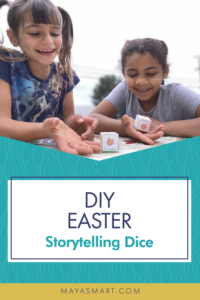
Sharing a good book with our little ones provides one of the best ways to teach young kids about important topics like the need to care for our damaged planet. Moreover, engaging in conversations and taking actions that reinforce the messages of the books we read together are some of the most valuable ways of building our children’s growing literacy skills and bringing home a book’s message. (Read our article on 7 Guaranteed Ways to Engage Kids with Family Read-Alouds to learn about why engaging around a book—beyond just reciting the words on the page—is so important.)
Taking your story time with your child and transforming it into a story time activity is a fun and powerful way to build that engagement. Here are three simple ways to create a sweet Earth Day story time activity.
Take Your Child on a Nature Walk Story Time
One of the first steps on the journey of raising children who care for the Earth is getting them out in nature. My nine-year-old son still fondly remembers the little nature walks he and I used to take while his older brothers were at school. What he doesn’t realize is that these walks not only helped build a foundation for his continued love of nature, but also built his pre-literacy skills, which have allowed him to excel as a reader. Here’s why:
Any walk in a natural environment is a great place to start building a love of the Earth. But adding a story time element brings even more learning and engagement to the activity, not to mention an extra chance for cuddles with even the most active of little ones, which will refill your tank as a parent and help them learn to love books.
Pack up a picnic blanket, snacks (in reusable containers, of course), and a few picture books about caring for the environment, or about interesting animals, nature, weather, or other related topics.
As you walk, point out bugs, plants, spiderwebs, and leaves. Conversation is one of the best ways to build pre-literacy skills, so engage your child’s questions and enjoy their wonder at all they see. Their interest in what they’ve seen will prime them for the message in Thomas’s book. When your child is ready for a snack, find a pretty spot to lay out your blanket. Bring out the snacks, reusable water bottle, and TuTu Goes Green or whichever stories you’ve chosen.
Point to the words on each page and engage in conversation about what you are reading and how it relates to the nature around you. This will help build and deepen comprehension. You can talk with your child about ways they are already like TuTu and come up with other ideas of how they can help care for our world.
Reinforce the Message with Recycled Art
Once you are home, a fun way to continue the learning and engagement around TuTu Goes Green is to set your child up to make art projects from reusable materials. Remind your child how TuTu loves to recycle and reuse things, and explain that you’ll show them ways to put some items around the house to a new use. Be sure to listen to their ideas, as well!
As any parent of young kids knows, packaging can often be as interesting as new toys (or more so). You can point out that when your child wants to play with a box, ribbon, or other interesting “trash,” they are reusing materials “like TuTu” and that this is a fun way to help the Earth. You can even help them set up their very own “reuse bin” where they can keep interesting “trash” to use in future art projects.
For older kids who are ready for a directed activity inspired by the story, making recycled pencil and pen holders, like TuTu has, is a fun way to deepen engagement with the book. All you need are some clean and empty plastic containers, paper, scissors, tape, and markers.
Just help your child cut the paper to fit around the container, have them draw a picture (possibly of nature from your outing together) and then wrap it around the container. Voila! Also check out our DIY Recycled Pencil Holder tutorial.
Put their Learning into Action with “Green” Signs
Kids who are inspired to be like TuTu and work to save the environment are sure to want to take some additional actions of their own. Another fun activity that will help kids connect letters to words and build literacy, while reinforcing the messages about helping the Earth, is to make signs to remind family members to turn off lights, use less water, and recycle.
Together with your child, cut cardboard from a cereal box, and use markers to make cute signs for your child to hang around the house. You can write these down for your child or help them write them, depending on their level.
Have your child make up their own messages or try these:
Save water: turn off the tap while you brush your teeth!
Save energy: turn off the lights!
Reduce, Reuse, Recycle
Finding ways to engage around the books we read to our children builds their comprehension of the written words and their understanding of what reading is all about. It will be a joy to see your little one inspired to be like TuTu and go green this Earth Day—and all year long!
Like this post? Share it!
Without a coordinated network of support, fugitives fleeing slavery faced a harrowing journey.
By Maya Payne Smart
Hundreds of Underground Railroad historical markers span the United States, conjuring images of covert escape routes, shrewd conductors, and clandestine connections. Such high-stakes adventure tales grip the American imagination, inspiring books and movies about antebellum liberty pursued and denied, borders permeated and fortified, identities shed and remade.
But Texas is seldom mentioned in this sweeping narrative of Black pursuits of freedom. The state’s landscape is bare of monuments to resistance and flight, of the names or narratives of enslaved people who liberated themselves or died trying. When Texans think of emancipation, Juneteenth is more likely to come to mind—the holiday commemorating the 1865 date when Union soldiers landed in Galveston and announced emancipation.
Yet, “the story of freedom in Texas is bigger than Juneteenth, and it started well before June 19, 1865,” says Daina Ramey Berry, chair of the University of Texas at Austin History Department and author of The Price for Their Pound of Flesh: The Value of the Enslaved, from Womb to Grave, in the Building of a Nation. “It’s in the stories of self-liberated enslaved people who were finding ways to get to Mexico, finding ways to get on boats and get to the Caribbean, finding ways to escape and go farther west.”
Historians are still unearthing tragic and triumphant tales of Texas freedom seekers, but it’s clear the Underground Railroad’s reputation for coordinated networks of abolitionists hiding people in barns doesn’t square with the historical reality in Texas. Racing south across unforgiving country, runaways—often armed and on horseback—faced daunting odds in a gauntlet of wilderness, slave hunters, and lawmen. “We need to figure out what the Texas story of the Underground Railroad was and maybe come up with a new term or a new label to describe the movement for freedom in the Lone Star State,” Berry says.
Mexico outlawed slavery in 1829, making it an obvious destination for freedom seekers from Texas and other states, such as Louisiana and Mississippi. But getting there required navigating slave states without the support or protection that was sometimes available in free states.
Nineteenth-century Texas wasn’t home to abolitionist societies eager to help runaways. And, considering the number of free Black people in pre-Civil War Texas never rose above a few hundred, hiding in plain sight wasn’t possible. As a result, assistance networks for fugitives in Texas tended to be loose and unstable, says Thomas Mareite, a French historian at Leiden University in the Netherlands.
In his studies of how enslaved people in the U.S. sought refuge, Mareite has found that most of the assistance offered to runaways—directions, guidance, supplies, or shelter—came from fellow Black people, sympathetic Mexican laborers, and to a lesser extent, German settlers who opposed slavery. Though technically “free,” Mexican migrant workers often labored with slaves and developed personal relationships with them. Their empathy, experience crossing the border, and Spanish made them able guides and intermediaries for runaways seeking to abscond south. Slaveholders were sometimes dismayed by the help Mexican laborers offered Black escapees, to the point that some Texas towns expelled Mexican workers from their jurisdictions altogether. Others opted to make examples of those who helped escapees by publicly whipping or hanging them.
Mareite mined municipal, county, and state archives; military and court records; and newspaper articles and “runaway slave” ads to uncover freedom seekers’ stories. But historical records are scarce: Runaways and their supporters carefully covered their tracks in the face of violence and persecution. “People were speaking out against slavery in Texas before the Civil War, but not that many people,” Mareite explains. “Those who did faced a lot of risks—mobs, lynching, brutal punishment.”
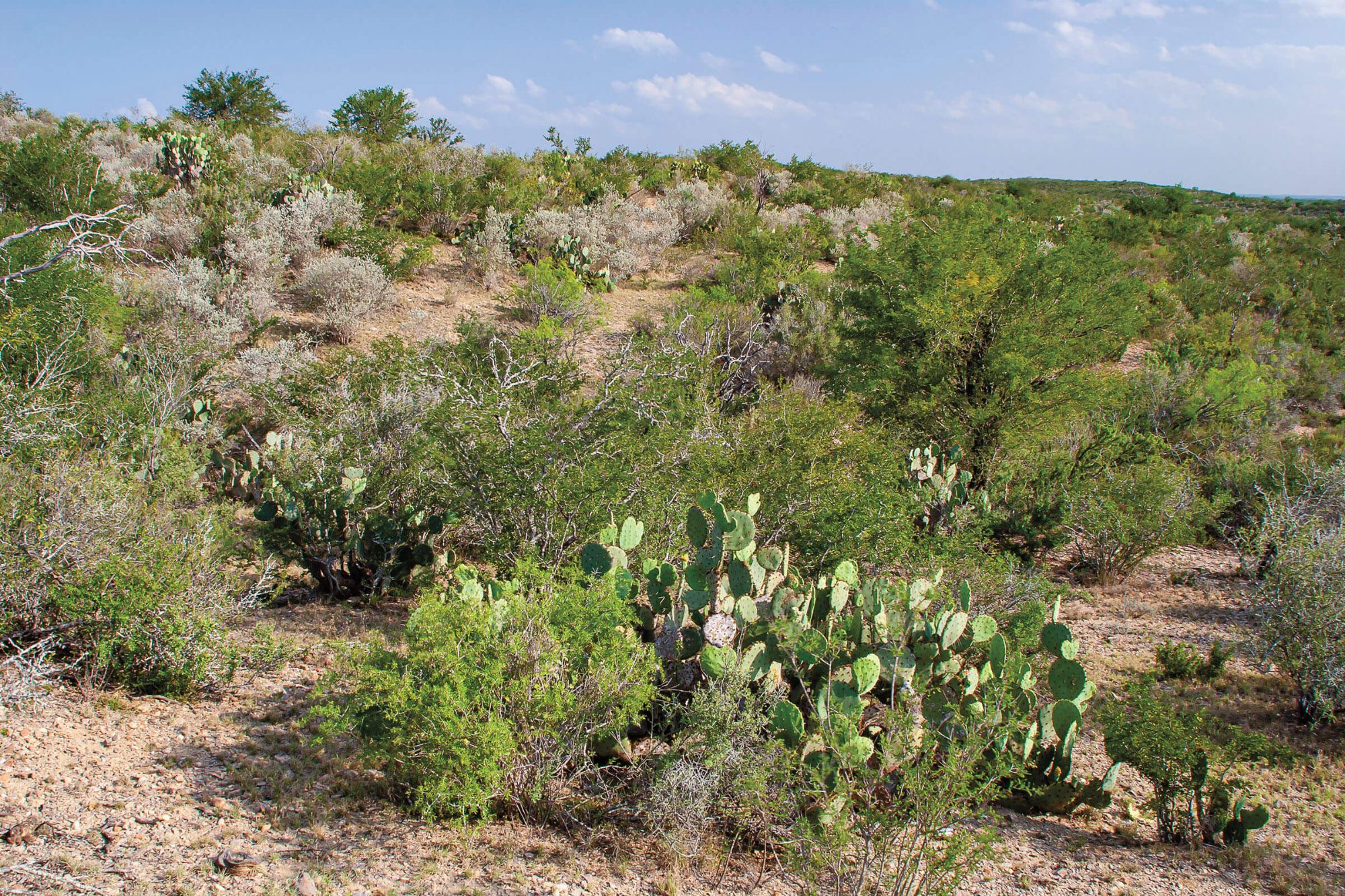
Ultimately, enslaved people relied on their own hard-won knowledge, skills, and provisions to pursue freedom. The Texas Runaway Slave Project, a database of historical records at Stephen F. Austin State University, has documented more than 2,500 escapees in Texas. Horseback skills, in particular, aided in the dangerous trek to the Rio Grande. Many enslaved men were skilled with horses from their experience driving wagons, plowing, and running horse-powered cotton gins. In fact, Texas runaways were 10 times more likely than those in Louisiana to take off on horseback, and 16 times more likely than enslaved people in Mississippi, according to the database’s project manager, Kyle Ainsworth, who penned an article on the topic for The Journal of Southern History.
Still, crossing the Nueces Strip—a lawless span of brush country stretching 150 miles between the Nueces River and the Rio Grande—was hazardous. “There’s not a lot of running water at all between those two rivers, there’s not a lot of shade, and it’s very hot,” says Roseann Bacha-Garza, a lecturer at the University of Texas Rio Grande Valley and the co-author of Blue and Gray on the Border: The Rio Grande Valley Civil War Trail. “But if they had a horse, and if they had a gun, they could make their way through.”
Many runaways didn’t survive. Their stories, too, are worth preserving. “I consider them very important because it tells us the story that even when their flight was not recognized or when those individuals don’t leave records, the history still existed,” says Maria Esther Hammack, a doctoral candidate in history at UT Austin.
Born and raised in Mexico, Hammack knew Mexico abolished slavery decades before the U.S. did. But as a college student in the U.S., she was surprised to learn that questions like “Who was the Harriet Tubman that led people to Mexico?” and “How many people sought freedom in Mexico?” hadn’t yet been answered. These subjects have fueled her research ever since. She’s scoured archives and databases in the U.S., Mexico, and Canada for years to recover moving, if fragmentary, evidence of countless quests for freedom.
Hammack learned of an ill-fated union between a Mexican man and his enslaved wife, for example, not from first-person narratives but from an 1842 issue of the Telegraph and Texas Register newspaper. The couple took two horses and fled from Jackson County in South Texas, but they were captured near the Lavaca River. The man, likely an indentured servant or peon, was lynched on the spot. His wife, considered property, was returned to her enslaver—and captivity.
For those who did make it to the Rio Grande, there’s evidence that sympathetic multiracial ranching families who settled along the river would shelter fugitives and help them get to Mexico. According to local oral histories, the Webber Ranch and the Jackson Ranch, which were located along the Rio Grande in Hidalgo County, harbored runaways.
Diana Cardenas, a descendent of settler Nathaniel Jackson, learned about her family’s role in helping runaway enslaved people from her grandmother Adela Jackson, who was born on the Jackson Ranch in 1899 and lived nearby until her death at age 93. “There were consequences for helping and assisting runaway slaves,” says Cardenas, who maintains a collection of family artifacts. “Regardless of what the consequences were, my [ancestors] put people first.”
Leslie Trevino started studying the Webber family’s history after marrying a descendent of John Ferdinand Webber and his formerly enslaved Black wife, Silvia. “When you look up the slave hunters, there’s actually more information about them,” Trevino says. “There’s not a record of the people who made it to freedom, or who were caught, or who were fighting on the side of freedom. There are records of those who were fighting against freedom.”
Once in Mexico, the formerly enslaved continued to face great adversity and experienced freedom that, at best, was conditional, Mareite says. The escapees had few job opportunities and little community support. They lacked formal paperwork declaring them free, and they lived in secrecy under the constant threat of recapture by mercenaries. “So it’s not slavery,” Mareite observes, “but it’s not entirely freedom.”
This story was originally published in Texas Highways magazine.
By Laila Weir
Calling all pregnant moms and parents-to-be! Literacy impacts everything from academic success to income to a person’s chances of avoiding incarceration. But did you know that most American children are falling short of where they should be in reading? And being behind in elementary school predicts long-term struggles.
To help your child achieve the reading success they need to pursue their full potential and create the life they deserve, you can build their language skills from the very beginning. How parents interact with their infants can have a profound effect on literacy, so don’t wait until they’re six months or a year old, or talking, or heading off to school to get started. In fact, the best time to start preparing their path to reading and writing is now—before they’re even here.
We realize the imminent arrival of your baby may be occupying most of your attention right now! But we invite you to dedicate a few moments to thinking about your longer-term plans. Once babies arrive they have a way of taking up your spare time: Before you know it, the months go by and your intentions may go out the window. A little preparation now can keep you on track during those fabulous but flying-by-the-seat-of-your-bathrobe days after Baby’s arrival.
Read through the tips below to hit the ground running when your little reader-to-be shows up.
Learn about the Benefits of Reading to Babies and the Smart Way to Read Aloud
Check out our series on how to maximize the benefits of reading aloud to your kids. They’re quick and easy reads with actionable tips, so don’t hesitate to dive right in. You’ll learn about the science behind literacy development and the little ways you can give your kids the best start possible. (Hint: Not all reading aloud is created equal.)
Get Some Basic Literacy Supplies on Hand
We know, we know: Diapers and baby clothes may be topping your list of what to stock up on, and we won’t argue with that. But this is also a good time to start thinking about what else you want to have for your little one.
This does not mean you need to go buy out the whole bookstore or educational supply store. In fact, you can get your baby off to a great start with just a few dollars and a library card! But having a few well-chosen literacy-supporting supplies around will make a big difference in raising your reader—just like having blocks available can pay dividends beyond keeping little hands busy (kids who play with blocks build spatial awareness that helps their math skills later).
Obviously, the key literacy supply to have on hand is—you guessed it—books. And we’ve got a post that will help you choose the absolute best baby books for building literacy from the get-go. Your local library should have plenty of options, and thrift stores also often carry baby books.
But, just like supporting literacy doesn’t start and end with reciting picture books verbatim (as you’ll know from the articles linked above), literacy supplies don’t start and end with a healthy bookshelf. Like just about anything else with young children, teaching early literacy skills should be a hands-on endeavor.
So check out our post on the best, easiest, most affordable literacy-supporting items for helping little ones learn letters and progress towards reading. Your infant will be a toddler before you know it, and preparing now to help them master their ABCs will ensure you’re ready when that day comes.
Follow Bookstagram Accounts that Recommend Great Children’s Books
Do you catch yourself scrolling mindlessly on social media? We get it. Here’s the good news: You can turn your scrolling into a literacy-building activity for your reader-to-be! In a happy, literary corner of the internet, #bookstagram accounts on Instagram offer an easy way to find reading recommendations and discover new authors.
Take time now to follow accounts that recommend positive books to help you build the family reading life you want. Then you can mindlessly scroll with a purpose during tired snuggles with your baby later on. Our post about bookstagrammers who share kids’ books and tips on building an inclusive children’s library will get you started. Soon your wish list will be chock-full of awesome reads for Baby—and maybe a few for you, too!
Let us know how else you’re getting ready to raise a reader in the comments.
By Courtney Runn
The snow has melted, but Texas is still reeling from last week’s historic winter storm. Days of freezing temperatures left millions of Texans without power and water, leading to medical emergencies, burst pipes, house fires, carbon monoxide poisoning, and food insecurity. As the state slowly recuperates, local nonprofits and mutual-aid organizations are rushing to provide storm relief.
In Austin, organizations have focused on water and food distribution, as both needs persist after the city lifted its water-boil notice. Many nonprofits, like the women and children’s shelter SAFE, are in need themselves after storm damage disrupted their ability to serve vulnerable communities.
We’ve compiled a list of seven Austin organizations providing storm relief, and ways you can help.
Austin Area Urban League
Austin Area Urban League launched the #LoveThyNeighborTexas campaign to spread awareness of housing-insecure communities and, so far, has raised more than $1 million. The organization is also distributing water at its headquarters. Donate.
Austin Disaster Relief Network
The Austin Disaster Relief Network has mobilized its 200+ church partners to provide warming shelters, water, food, showers, laundry service, and cleanup.
Black Leaders Collective
A collaborative effort between Central Texas Leaders, the Black Leaders Collective serves to “advocate and amplify the Black community by uniting a coalition designed to take charge and fight for our values.” Donate.
Community Resiliency Trust
The Community Resiliency Trust is partnering in efforts to distribute water and food. The organization is also looking for volunteers who speak Vietnamese, Arabic, or Mandarin to make sure all Austinites are aware of available resources. Volunteer or donate.
DAWA Heals
DAWA Heals, “a safety net for people of color who are experiencing short term life crisis,” is amplifying local organizations and has distributed $32,000 in emergency cash assistance. Donate.
Front Steps
In its mission to care for people experiencing homelessness, Front Steps has been distributing food, water, and blankets to those in need. The organization is currently accepting bottled water at its downtown headquarters. Donate.
SAFE
SAFE, a shelter for survivors of domestic violence and sexual assault, has continued to offer 24/7 support for anyone in need, despite experiencing severe water damage after the storm. The nonprofit is currently asking for help in fulfilling its Amazon and Target wishlists. Donate.
Happy Women’s History Month! What a wonderful time to highlight and celebrate the groundbreaking contributions women have made to our world. From being pioneers in several fields to careers as inventors, authors, athletes and so much more, women have made a tremendous impact in society, and continue to do so to this day. It’s never too early to learn about how women have shaped the course of history, showing courage, wisdom, and empowerment.
So how did it all start? Women’s History Month began in Sonoma, California in 1978. The local school district planned a weeklong celebration to honor women’s contributions. In 1980, President Jimmy Carter declared the week of March 8th as International Women’s Week. After a petition from the National Women’s History Project, an organization known as the only clearinghouse providing information and training in multicultural women’s history, Congress expanded the celebration to the entire month of March in 1987.
If you’re looking for some empowering books to enjoy with your child for Women’s History Month, here’s a curated selection of illustrated reads by and about a diverse set of amazing women. You’ll also want to check out our post on picture books by Toni Morrison!
Which picture books look appealing as you create your child’s Women’s History reading list? Let us know which ones you choose and if you have any other favorites!
As a teacher, I love to make a themed activity that goes beyond a simple craft (though I love a good craft too), and an Easter egg hunt is a fun option to mix up our playground time when spring rolls around. But if I gave my four-year-olds a bunch of candy in the middle of the day, I’d have kids bouncing off the walls like pennies in a tin can!
So I created this sight-word Easter egg hunt, instead. Why sight words? Well, sight words—also called high-frequency words—are words children come across often, but which aren’t easy to sound out. For example, kids will see the word come a lot, but imagine trying to sound that out as a brand-new reader. Or they learn that A makes the “short vowel” sound like in apple and then can’t understand the word are. Some very common sight words are: a, are, the, he, she, we, I, no.
We teach children to recognize these words by sight, hence the nickname. This means that the more children are exposed to these words, the faster they’ll pick them up and add them to their reading arsenal. This egg hunt literacy game is a fun way to celebrate the season (without the sugar rush), get kids active, and keep them learning in a playful way. Ready? Let’s hop to it!
Sight Word Easter Egg Hunt Tutorial:
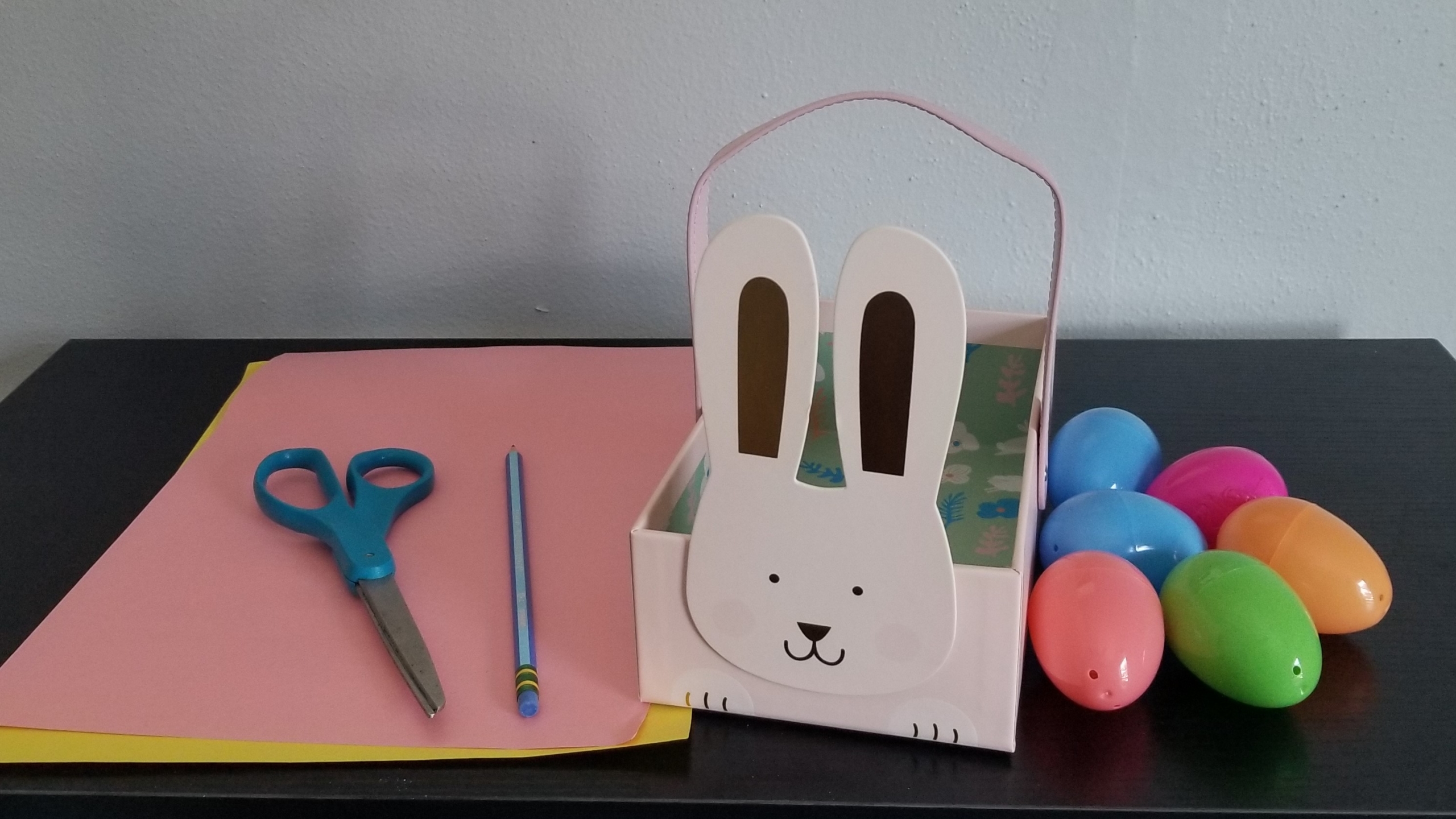
Materials Needed:
- Plastic Easter eggs
- Easter basket or other container for collecting eggs
- Paper (multiple sheets)
- Pencil or marker
- Scissors
- Tape
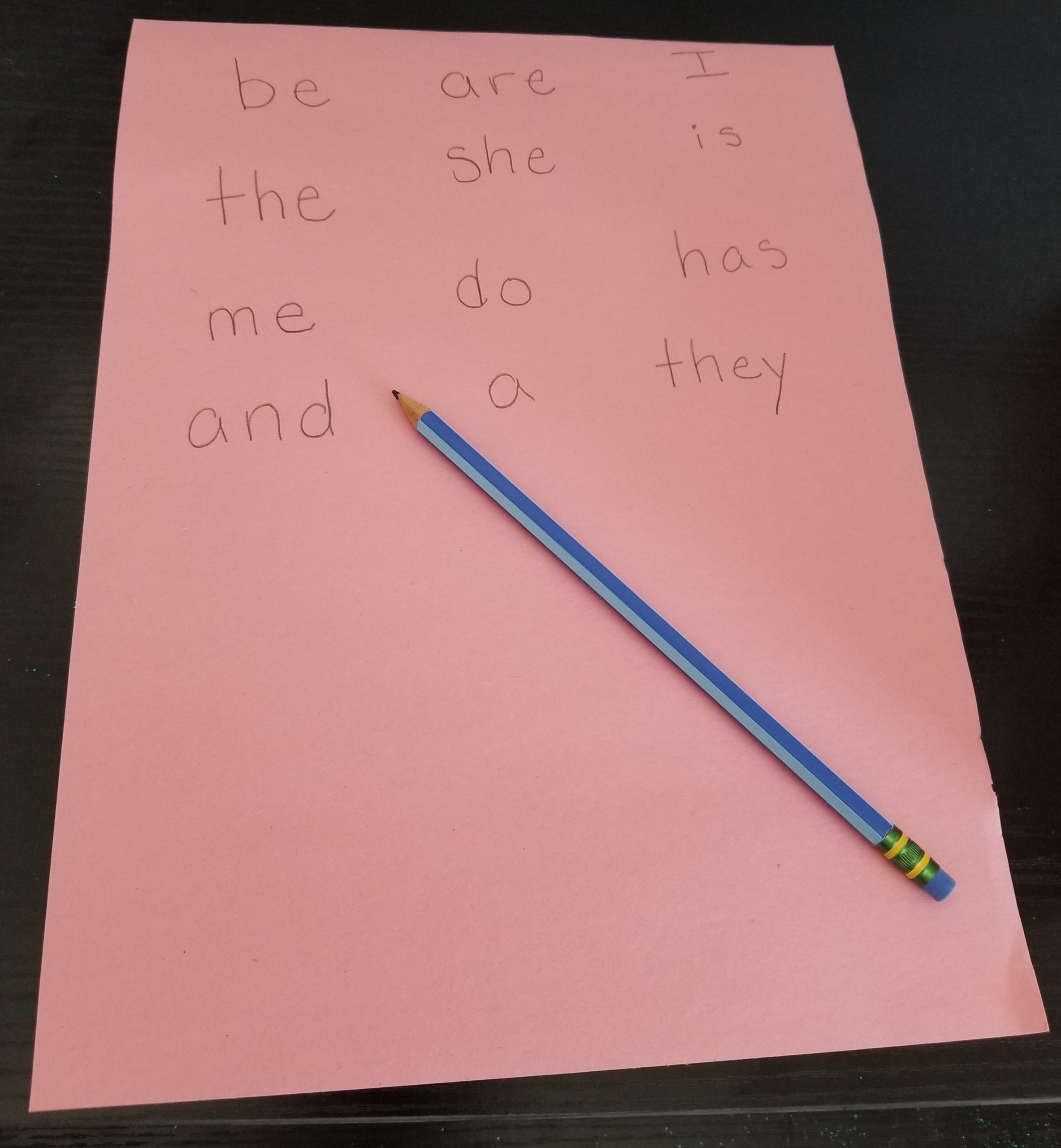
Step 1: On a piece of paper, write down 10 to 12 sight words (or words your child is working on). If you aren’t sure which sight words to use, you can ask your child’s teacher for a list or review websites like Sightwords.com for a comprehensive list. For pre-readers, you can also do this activity with uppercase or lowercase letters to help your child learn their ABCs.
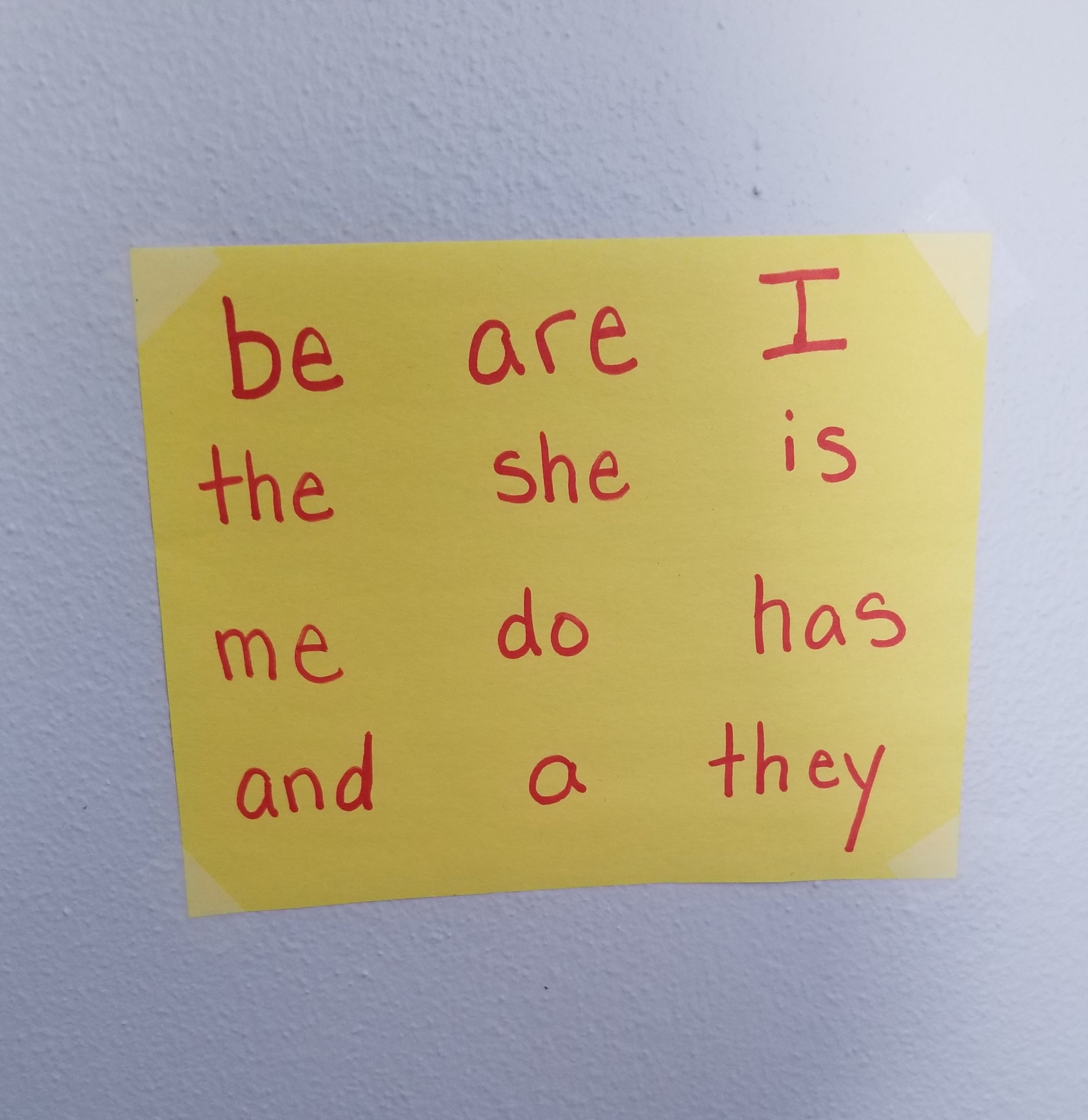
Step 2: Write the target words (or letters) on a second sheet of paper and tape it to the wall, at your child’s eye level if possible.
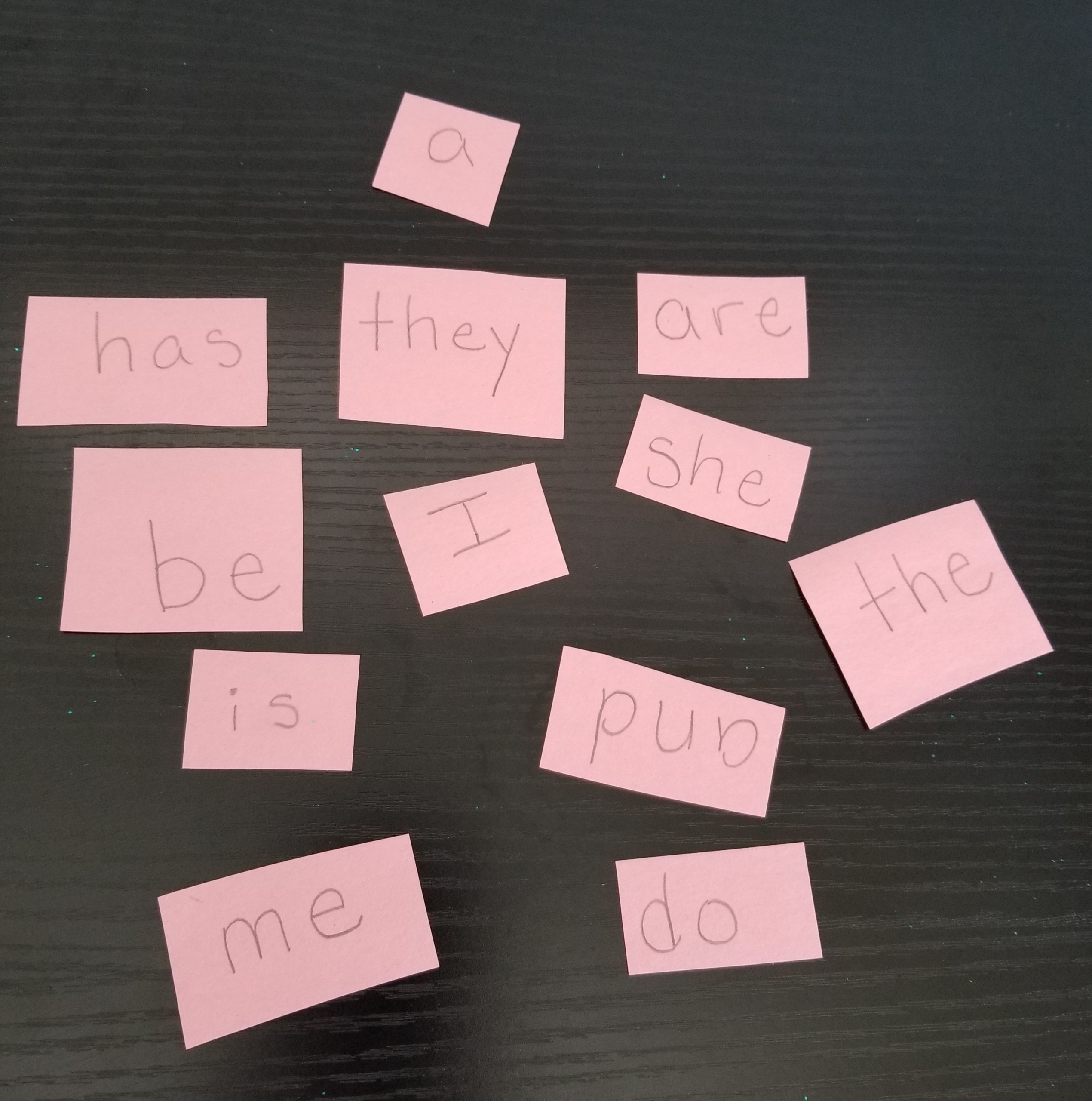
Step 3: Cut out each individual word or letter from the first sheet of paper, and then place each in a plastic Easter egg.
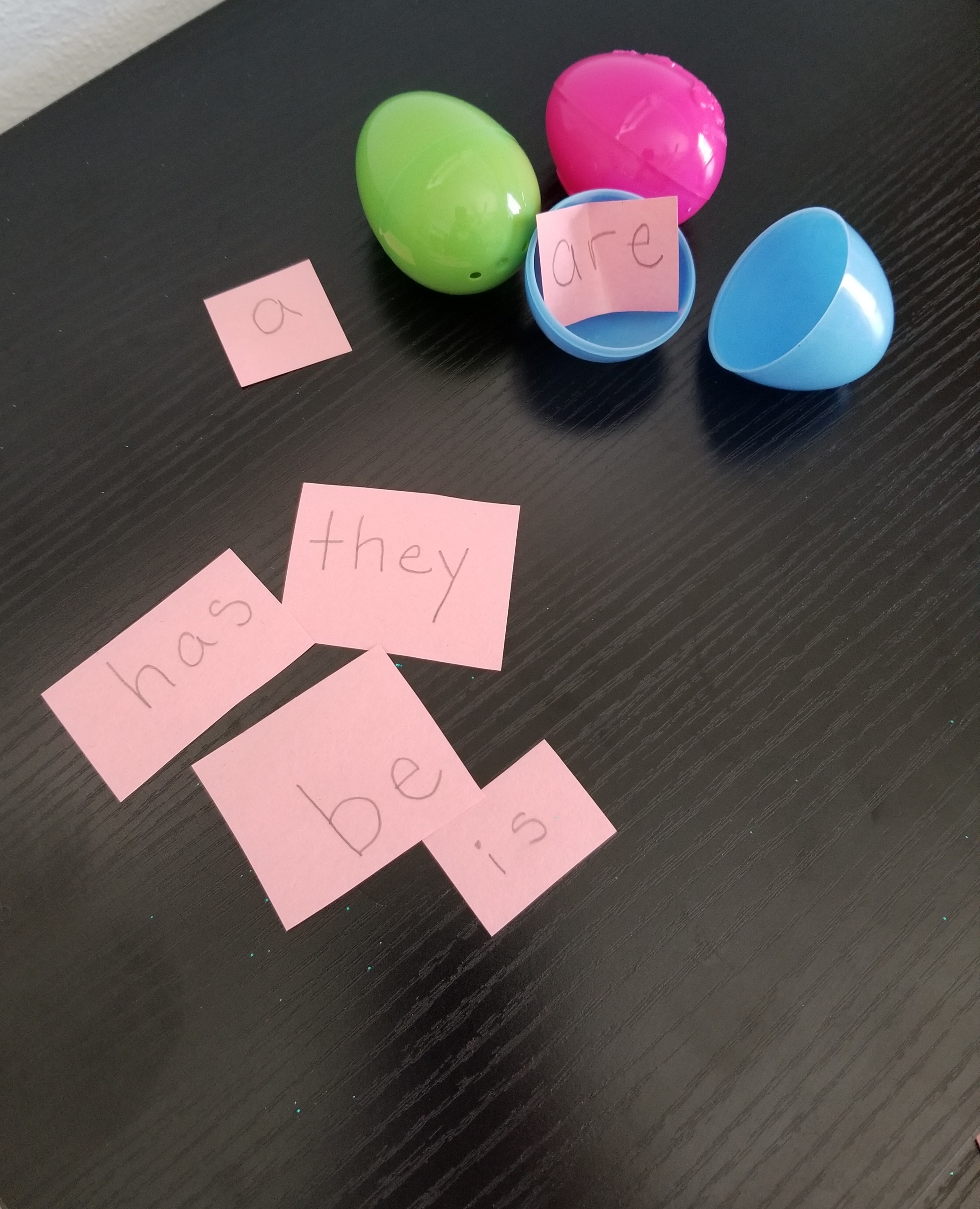
Step 4: Hide the eggs around your home or yard.
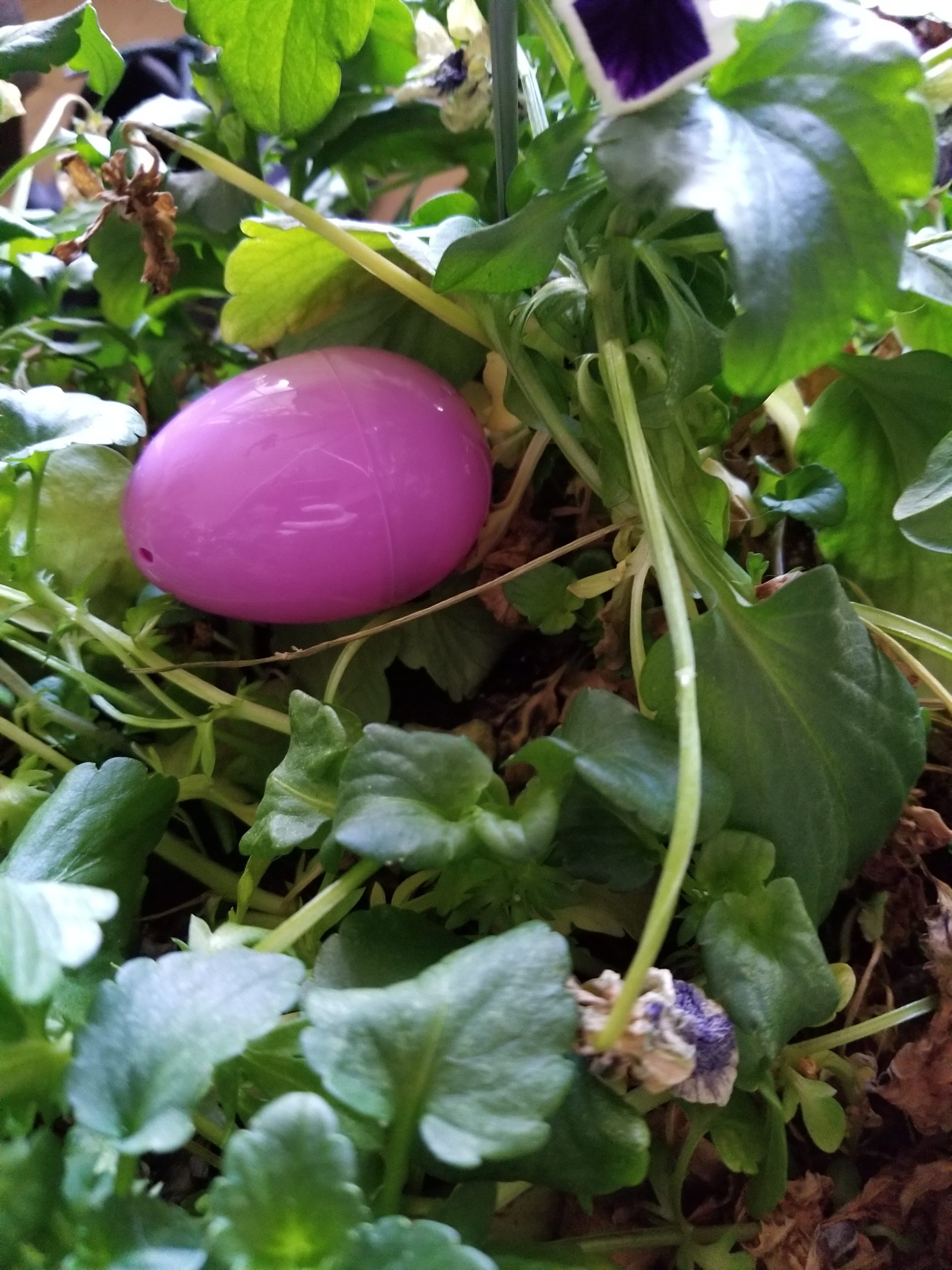
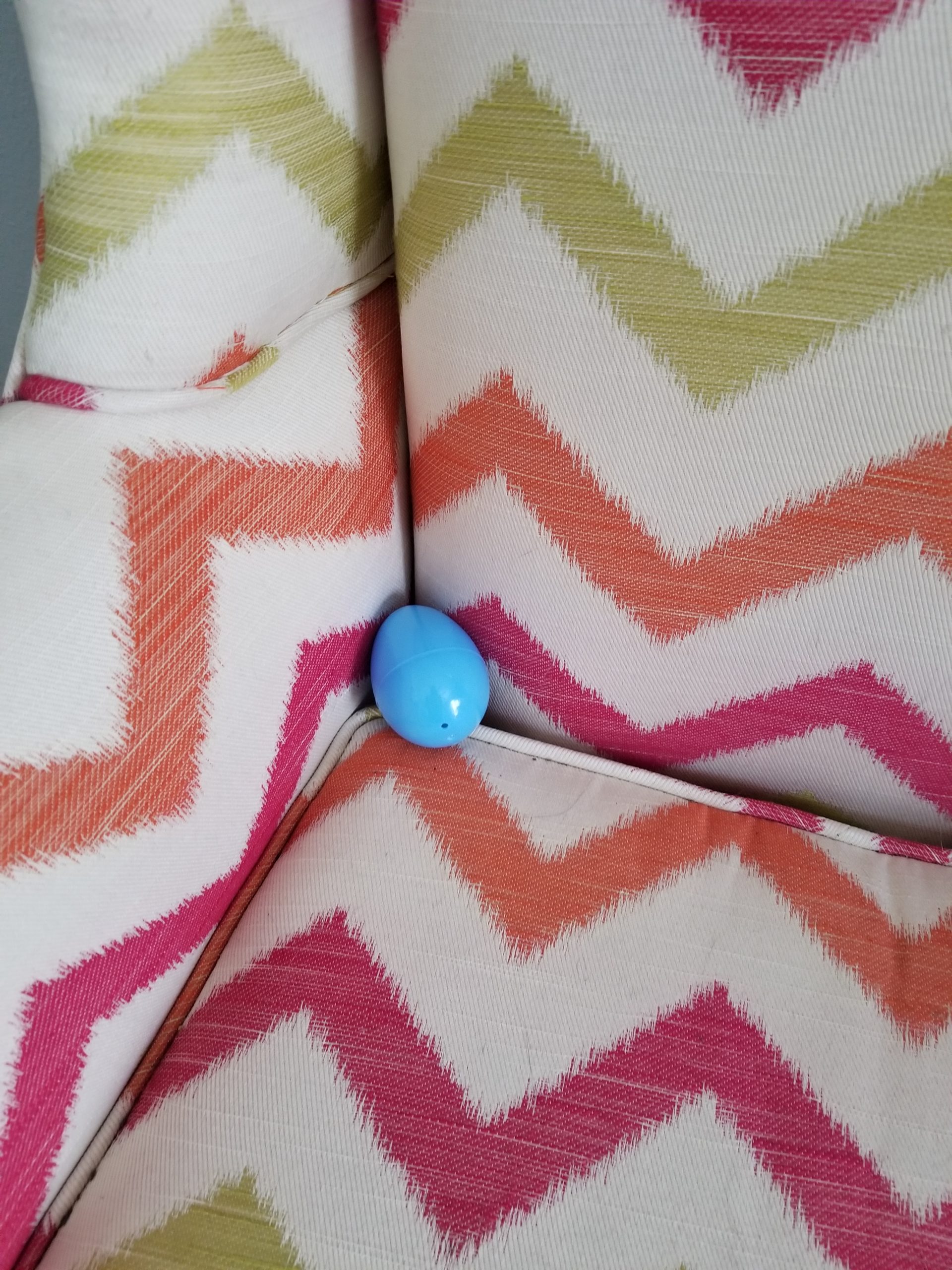
Step 5: Show your child the list of target words or letters on the wall and review each one with them. Then send them on an Easter egg hunt!
Once they’ve collected their eggs, have them bring the eggs back to the posted list and match what’s inside to the writing on the wall. Which words or letters did they find? Have they found all of them? Can they remember what each one says?
Optional: If your kid is going to expect sweets once you’re dabbling in Easter eggs (we get it!), or if you have some leftover Easter candy to dole out, you can give out candies as prizes in return for their found sight words or letters. Just let them turn in each paper that they successfully read for a piece of candy. (And let them try to read each as many times as it takes to succeed!)
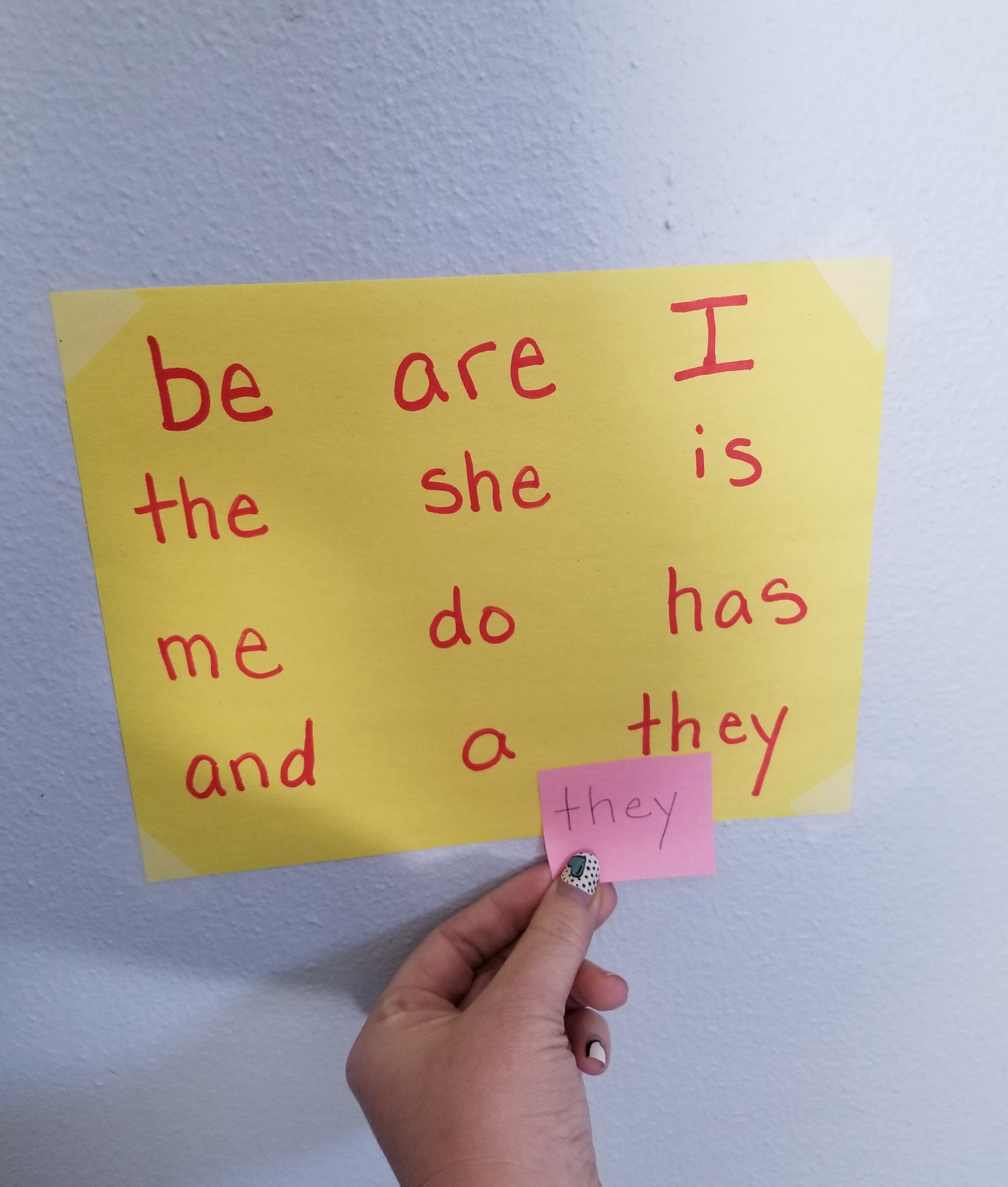
Like many of my favorite activities, this is one you can do again and again—it doesn’t have to only be at Easter. You can change up the sight words as your child gains mastery. And being a Dollar Store Diva myself, I love that I can get these plastic eggs on the cheap.
Now, have fun … I hope you have an egg-cellent time!
Enjoy this post? Share it!

Award-winning author Toni Morrison is well known for her powerful writing that examines the black experience in America, with a particular focus on women and girls. Both a Nobel Prize and Pulitzer Prize winner, she is best remembered for her classic novels The Bluest Eye (1970) and Beloved (1987), which was later adapted into a movie with Oprah Winfrey’s support. Her vast and impressive body of work includes 11 novels, nine non-fiction books, two short stories, and two plays.
What many people don’t know about Morrison is that her works also include eight children’s books that she wrote along with her son, Slade Morrison. These delightful and whimsical stories explore a variety of themes that will make excellent conversation starters during family read-alouds. You can use them to spark reflection, and ask your children how they relate to the stories. Check out our post on read-aloud styles to learn about the importance of interaction during story time. In addition to engaging your child in discussion around the books’ themes, and building on their questions about the stories, you can also point to sight words or letters your child may recognize as you go through the pages. This develops their print awareness, a key pre-reading skill.
Children’s Books by Toni and Slade Morrison
Let us know if you’ve read these books with your child and which are your favorites!


